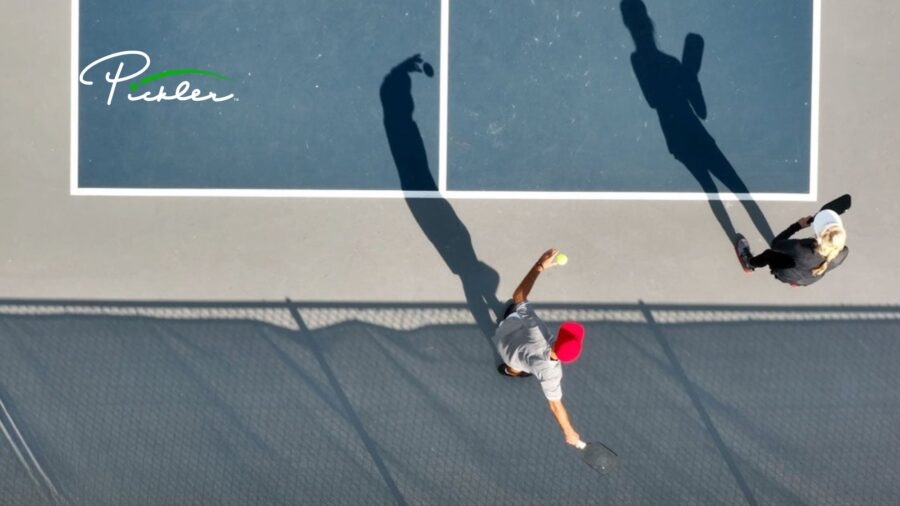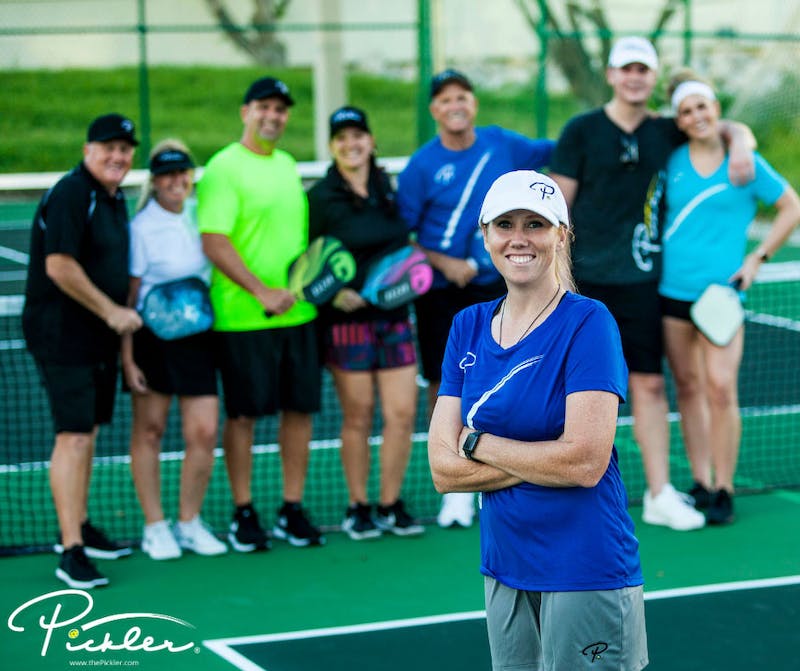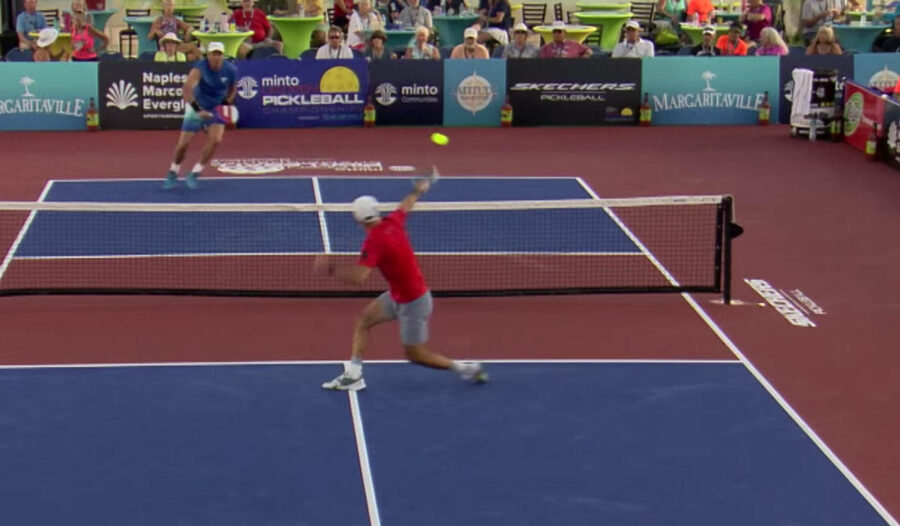Every point in a pickleball game starts with a serve. Although the serve in pickleball can be a very basic shot, it is a very important shot in every point. Not many points are won in a pickleball game off of an ace serve; however, many opportunities are lost by serves that are hit out of bounds. Further, if you can perfect your serve on the pickleball courts, you may also be able to give yourself an edge over your opponents with a strong, strategic serve.
What are the key pickleball serve techniques? What are the key pickleball serving strategies? This blog and pickleball serve video below break down seven of the best pickleball serving tips to take your pickleball serve to the next level, which include key pickleball serve technique tips and key pickleball serving strategy tips!
Basic Pickleball Serving Rules – How to Serve in Pickleball
Pickleball uses an underhand serve (unlike tennis, which has an overhand serve). The rules of pickleball require the serve to be hit below your navel (in other words, your belly button) with, at the point of contact:
- Your arm moving in an upward arc (to note, you may hit the serve with either a forehand or backhand motion); and
- The highest point of your paddle head being below the highest part of your wrist (which is the point on your wrist where your joint bends).
After contact, you are free to do whatever you want with your pickleball paddle.
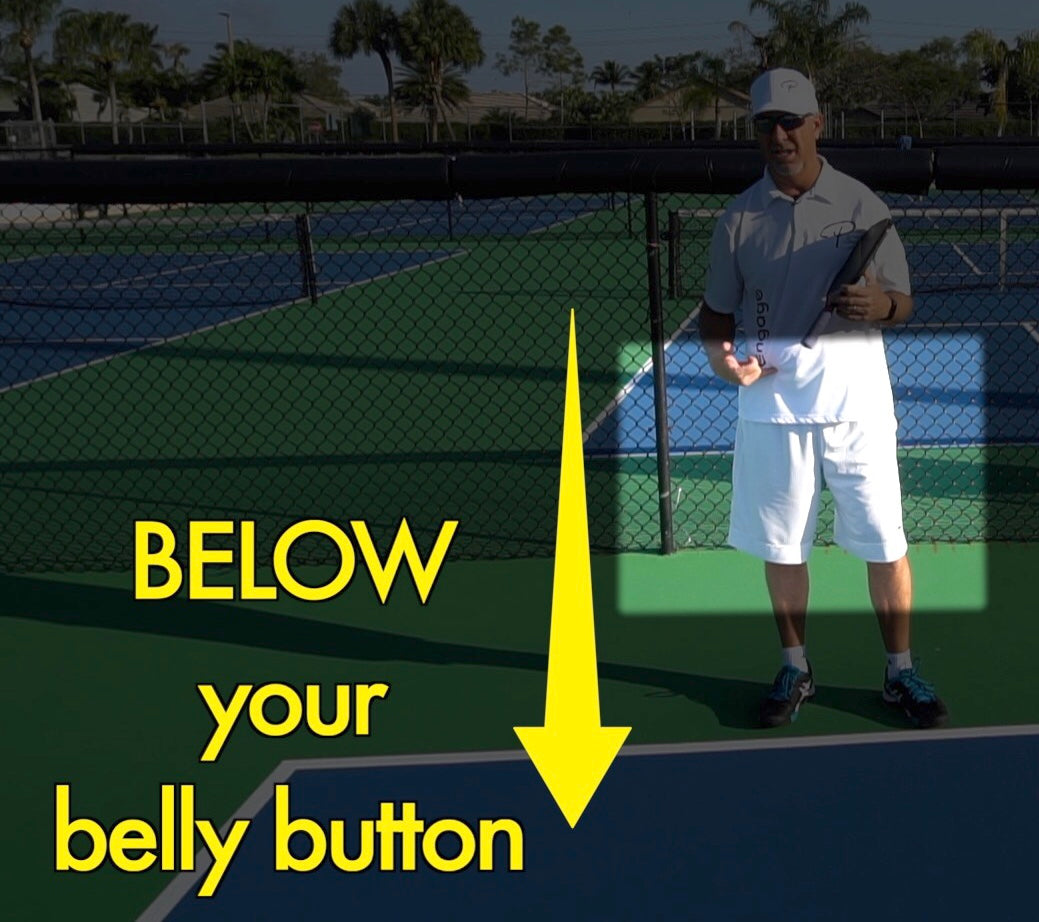
Foot Placement When Serving
Also, to note, your foot placement is important at the point of contact on your serve in pickleball. At the point of contact between your paddle and the pickleball on your serve, at least one foot must remain in contact with the ground behind the baseline.
Neither of your feet may touch the pickleball court on or inside the baseline, or on or outside of the imaginary extension lines of the applicable sideline or centerline. After you make contact on your serve, you are free to place your feet on the pickleball court wherever you see fit, including on the baseline, or outside of the imaginary extensions of the sideline or centerline.
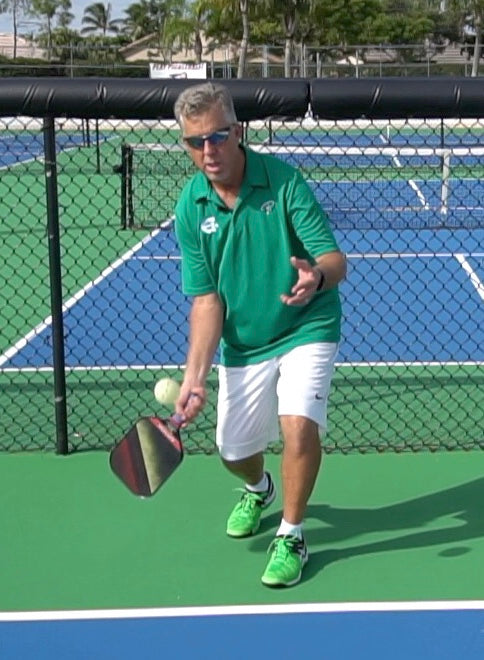
Pickleball Serving Tip #1: Find a Pre-Serve Routine that Works for You & Stick to It
It is important that you find a routine that you are comfortable with before you serve the pickleball on the pickleball court. This pre-serve routine could be bouncing the pickleball with your hand, hitting the pickleball a few times with your paddle, or fixing your hat – whatever works best for you and whatever you feel comfortable with.
This pre-serve routine is a trigger to make sure you are both mentally and physically ready for the point. Pre-serve routines can also help you improve your timing. Find your own pre-serve routine, so you are ready to play and win the point!
Whatever your pre-serve routine is, be sure to include saying the score aloud before your pre-serve routine. Have you ever hit your serve out of bounds or into the pickleball net because you were saying the score and serving at the same time?
To avoid this, you should say the score before you start any part of the serve. In other words, do not say the score and serve at the same time. This is because our bodies and minds are generally not built to think and do at the same time. So, think, say the score, do your pre-serve routine, and then serve.
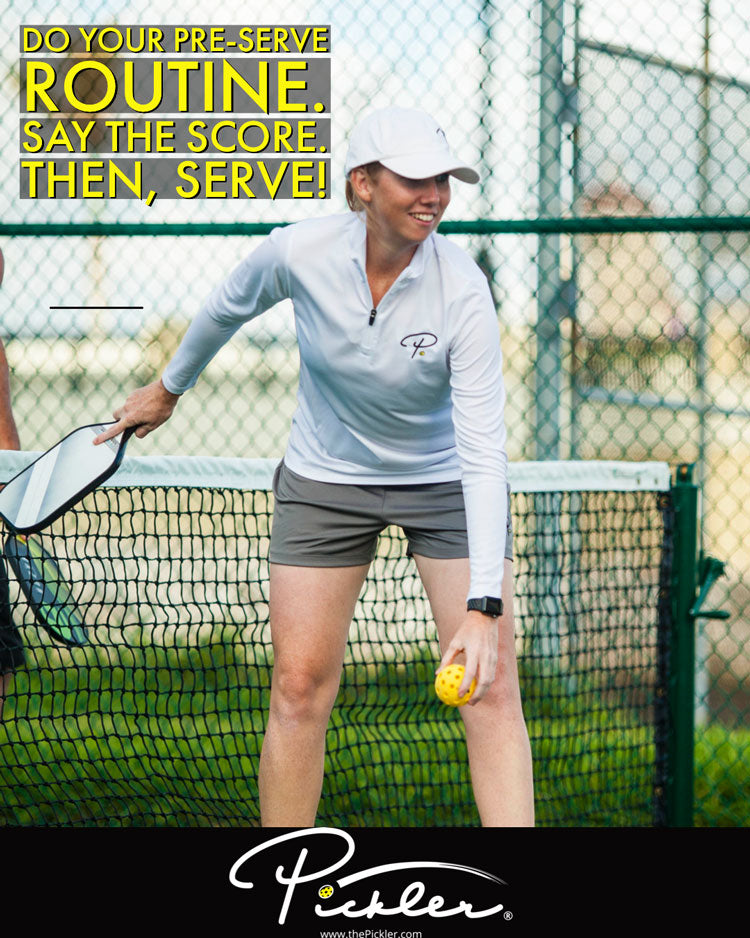
Pickleball Serving Tip #2: Perfect Your Pickleball Serving Technique – Stay Loose, Move from Your Shoulder & Finish Your Swing Through the Pickleball
During a serve on the pickleball court, some pickleball players have a tendency to want to flick their wrist or bend at their elbow. Flicking the wrist or bending at the elbow is not recommended, as these tendencies could cause inconsistencies in a pickleball serve, as they are hard to precisely repeat. The goal on the pickleball serve is to perfect a consistent, reliable serve, and a service motion that is difficult to repeat will lead to an inconsistent, unreliable serve.
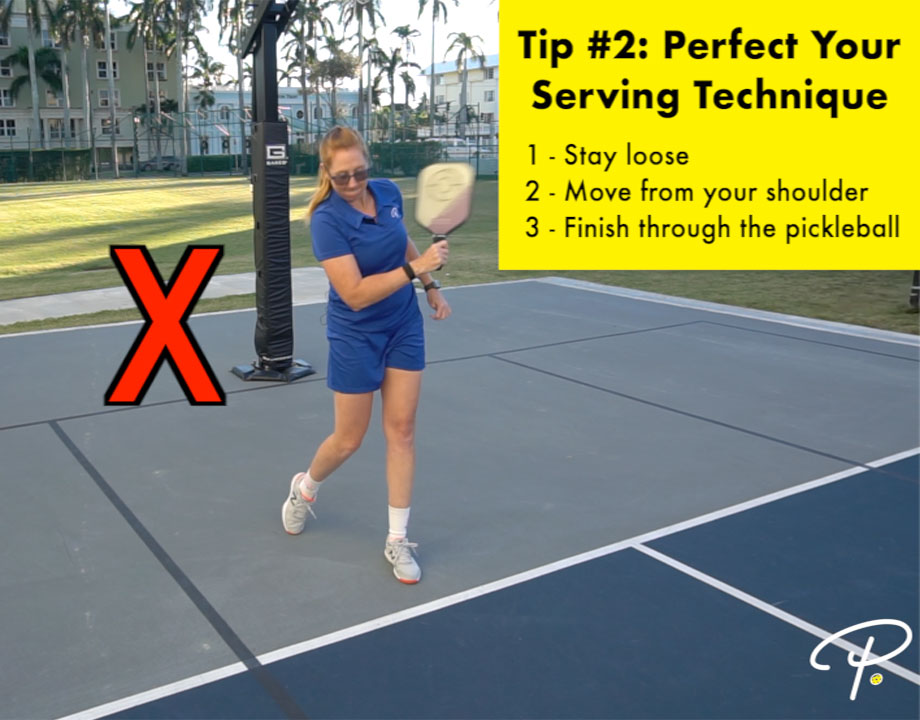
Rather, a pickleball service motion should be more like a pendulum swing from the shoulder, instead of from the wrist or elbow. The pickleball service motion should be fluid and loose, rather than stiff or tight. This fluid and loose motion will be more easily repeated for a consistent, reliable pickleball serve.
Further, this fluid, loose motion should start with a small backswing and continue all the way through the pickleball. The pickleball service motion should not stop at contact with the pickleball, but rather continue through contact, as if you were hitting several pickleballs in a row in the direction that you want the pickleball to go – which would be to the crosscourt service box, or even more specific as a very detailed spot in the crosscourt service box (for instance, to the corner by the sideline or to the corner by the centerline on the pickleball court).
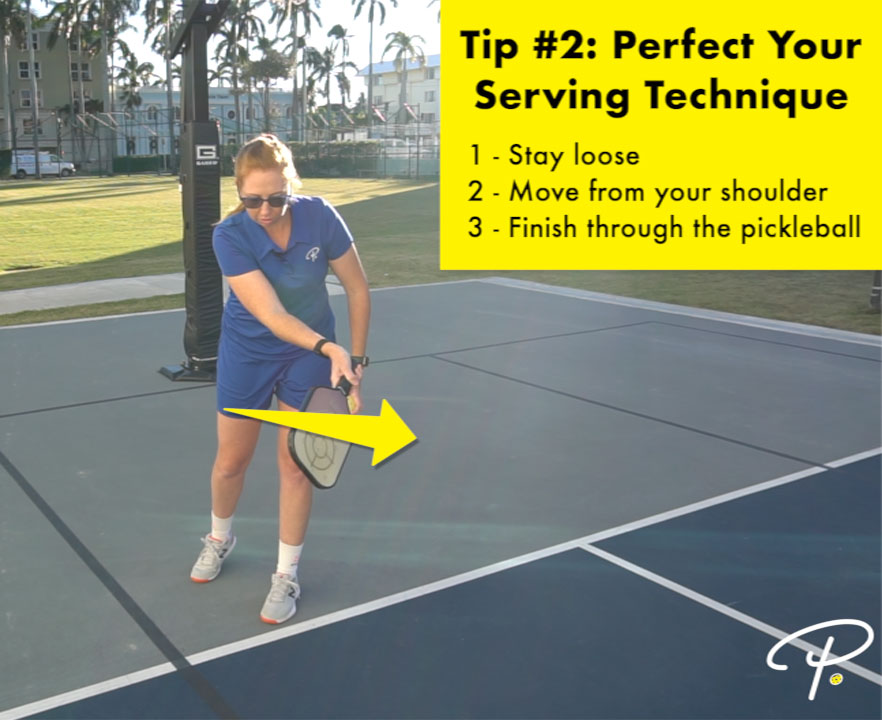
Pickleball Serving Tip #3: Use a Semi-Closed Stance & Avoid Over-Rotating on Your Pickleball Serve
Oftentimes, pickleball players serve by pulling open with their non-paddle side, which opens up their bodies to the pickleball court. In other words, some pickleball players turn too much. If you rotate too much on your backswing or follow through during your pickleball serve, you will likely hit the pickleball on its side, which will be more difficult to control and remain consistent.
To avoid this common mistake on the pickleball serve, it is important to:
- Avoid over-rotating on your backswing – When taking your backswing, be sure not to over-rotate with your feet or shoulders, which could cause your pickleball paddle to get behind you. This may lead to some inconsistency in the direction of your pickleball serve and lead to unnecessary unforced errors.

- Use a semi-closed stance – A semi-closed stance is a stance that is partially open to the crosscourt service box and partially closed to the crosscourt service box. A semi-closed stance will help deter backswings that are too big and cause over-rotation, while allowing you to keep your point of contract between the pickleball and your pickleball paddle relatively tight to your body.
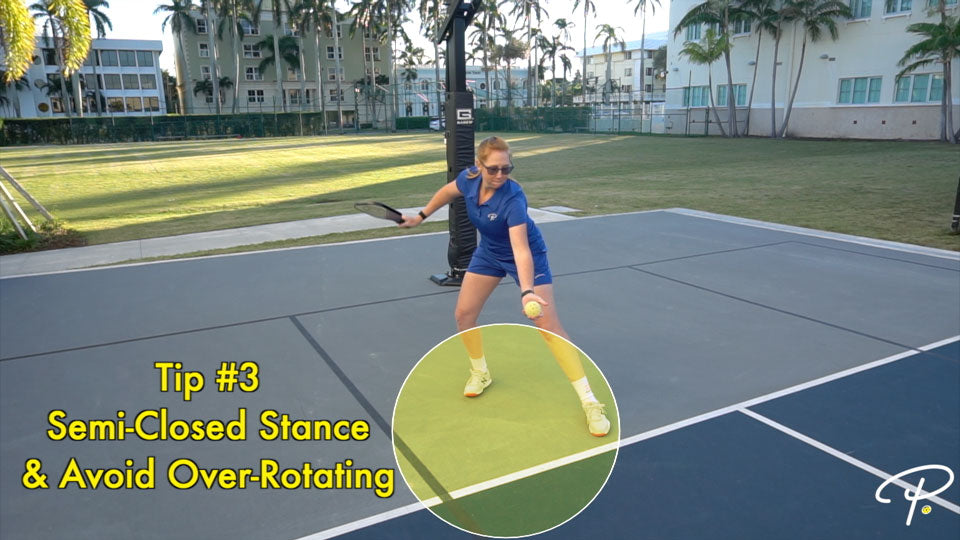
- Make contact with the pickleball relatively close to your body and in front of your body – It is important to make contact with the pickleball out in front of your body and relatively close to your paddle-side waist. This point of contact not only allows you to generate power, as you are able to use more of your body, but it also provides for a more consistent shot. If you make contact with the pickleball away from your body or behind your body, your pickleball paddle will lag behind you, which results in an inconsistent point of contact between the pickleball and the pickleball paddle on the serve.
Pickleball Serving Tip #4: Generate Power on Your Pickleball Serve – Use Your Legs & Core
To generate additional power or pace on your pickleball serve:
- Perfect your pickleball serving technique (in other words, perfect the pickleball serving tips described above);
- Once you perfect your pickleball serving technique, try to generate more paddle speed through your pickleball serving motion; and
- Engage and use your legs and your core to strike the pickleball, as your legs and your core are some of your strongest muscle groups. To engage your legs and core, use an athletic stance on your serve, which includes compressing your legs.
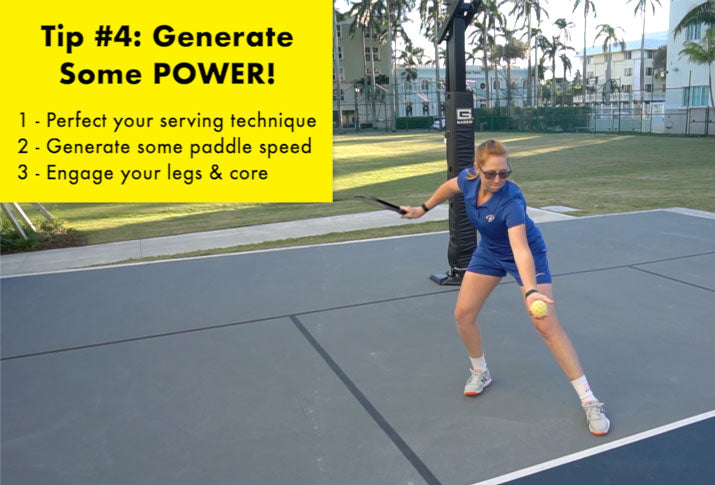
Pickleball Serving Tip #5: Give Yourself a Consistent Pickleball Toss or Pickleball Drop
When serving the pickleball, it is important to set yourself up for success by giving yourself a consistent toss on a traditional pickleball toss serve or a consistent drop on pickleball drop serve.
Pickleball Toss Serve
When using a pickleball toss serve on the pickleball court, lift the pickleball before releasing it. If you simply drop the pickleball, the pickleball will be too low at the point of contact and create a more difficult shot for you.
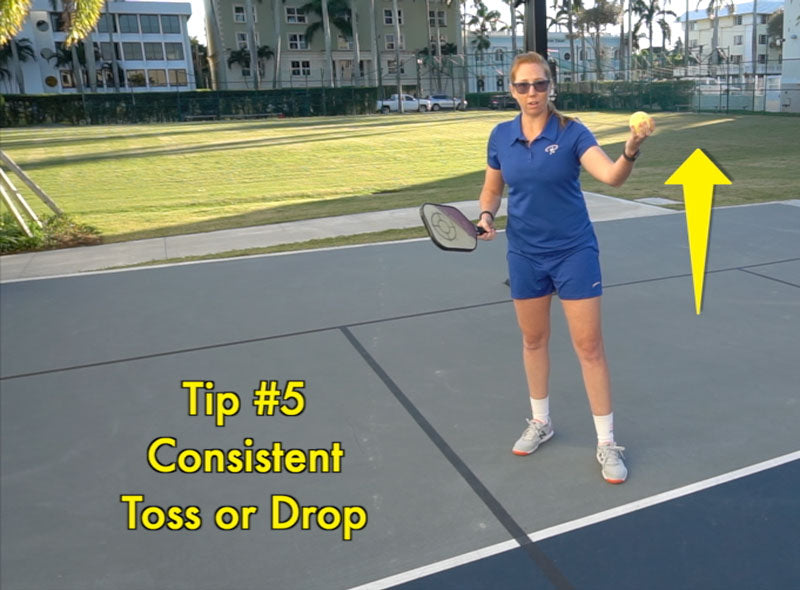
Pickleball Drop Serve
When using a pickleball drop serve on the pickleball court, drop the pickleball with your non-paddle hand from a comfortable height above your head with your arm slightly out in front of your body and slightly toward the paddle side of your body.
By extending your arm above your head, you will give yourself the highest bounce possible (i.e. more gravitational pull), and, by extending your arm slightly in front of your body toward your paddle side, you will drop the pickleball in a manner that gives it the best chance to bounce to an ideal point of contact – out in front of your body and slightly on your paddle side.
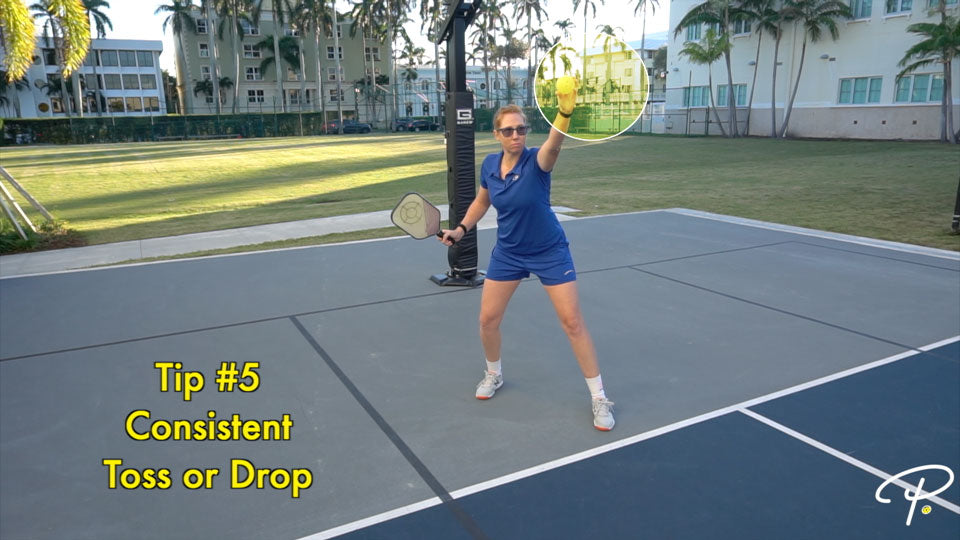
Watch the Pickleball
It probably goes without saying, but one of the easiest mistakes to make on the pickleball court is not watching the pickleball to the point of contact. So, with that said, be sure to watch the pickleball hit your pickleball paddle on your serve. Keep your head down when striking the pickleball on the serve, rather than on where the pickleball is traveling to.
Pickleball Serving Tip #6: Pickleball Serving Strategy – Serve Deep to Backhands
One pickleball serving strategy is to serve deep to your opponents’ backhands. This is because, a deep serve pushes your opponents back on their side of the pickleball court, making the return of serve more difficult for them.
Further, in most cases, your opponents’ backhand shots will be weaker than their forehand shots. Targeting your opponents’ backhands causes your opponents to either:
- Hit a weaker backhand return of serve; or
- Move and run around your serve, which can open up room on the pickleball court for placing your next shot.
However, make sure you mix in a serve or two to your opponents’ forehands to keep them honest. If you are too predictable, your opponents will cheat to anticipate your shot. If you come across an opponent with a strong backhand, then you may need to change this strategy to be a bit more unpredictable and move your serve around on the pickleball court.
When targeting a deep serve to your opponents’ backhands, do not overplay the serve and aim too close to the lines of the pickleball court—whether it be the baseline, the center line or the sidelines.
Instead, aim about two to three feet inside of the lines. And, do not forget to consider and factor in the wind on your pickleball serve, as wind can certainly play games and cause the pickleball to move in directions you may not have wanted!
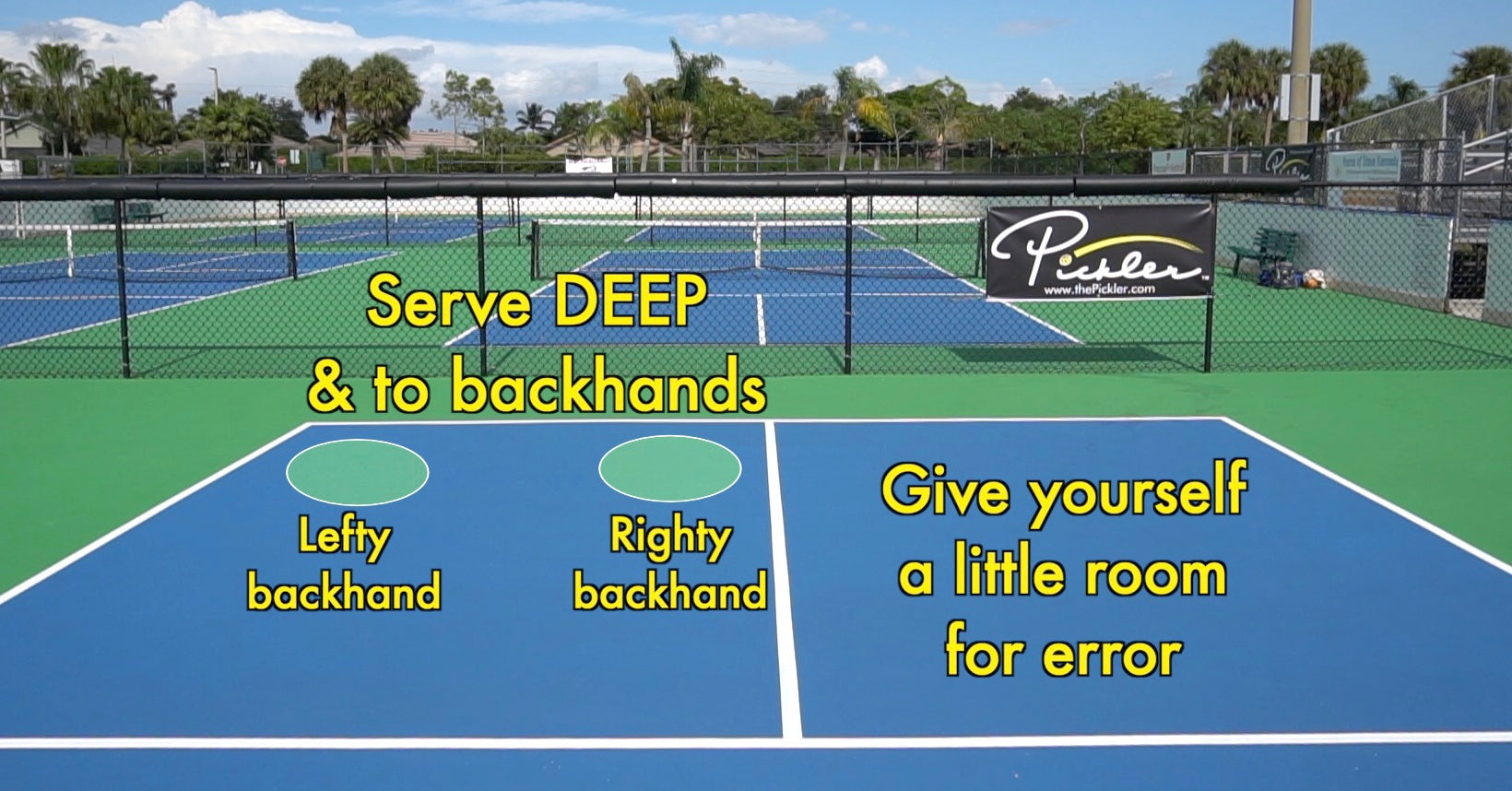
Pickleball Serving Tip #7: Mix Up Your Serves!
Every pickleball player should, at a minimum, have a serve that is incredibly consistent. As a result, it is important to practice pickleball serving drills (such as serving a bucket of pickleballs to targets on the opposite side of the pickleball court) until you have at least one incredibly consistent serve.
Options for the Serve in Pickleball
Once you have a consistent, reliable serve, then you can elevate your pickleball game to incorporate different types of serves. There are many different options for the serve in pickleball. For instance:
- A driving serve, which is a serve with a lot of pace or speed on the pickleball;
- A lob serve, which causes the pickleball to take a very high trajectory and a higher bounce off of the pickleball court;
- A top spin serve, which causes the pickleball to nose dive into the court and take a higher bounce;
- An inside out, which puts side spin onto the pickleball and causes the pickleball to curve to the right if hit by a right-handed player and to the left if hit by a left-handed player;
- A hook serve, which puts side spin onto the pickleball and, because the server gets some top spin onto the pickleball, causes the pickleball to curve to the left if hit by a right-handed player and to the right if hit by a left-handed player;
- A drop serve, whereby the pickleball player hits the serve off of a bounce, which could alter timing or allow the serve to get aggressive top spin or backspin on the pickleball; and
- Other creative serves!
To keep your opponents off balance, and gain an additional edge on the pickleball court, mix up your serves to keep your opponents guessing. You may score some easy points by mixing up your serve and you may even find that your opponents struggle with a particular serve over others. So, perfect one consistent serve and then continue to evolve your pickleball game by adding each of these other unique pickleball serves to your repertoire.
Now, get out onto the pickleball courts and incorporate these pickleball serving tips into your pickleball game for a killer pickleball serve!
And, for more videos and information that break down every aspect of the sport of pickleball, including how to hit the various serves as well as pickleball mechanics, fundamentals, strategy, advanced concepts, and drills, check out Pickler’s online video collection!


